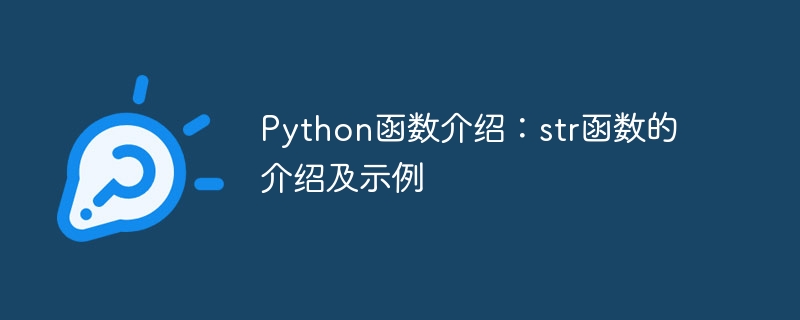Home >Backend Development >Python Tutorial >Introduction to Python functions: introduction and examples of str function
Introduction to Python functions: introduction and examples of str function
- 王林Original
- 2023-11-03 15:36:461413browse

Introduction to Python functions: introduction and examples of str function
Python is a simple and easy-to-learn programming language with a wealth of built-in functions to help developers process data. One of the commonly used built-in functions is the str function. The str function is mainly used to convert other data types into string types.
The usage of the str function is as follows:
str(object, encoding='utf-8', errors='strict')
- object: can be anything An object, including numbers, lists, tuples, dictionaries, etc.
- encoding: Optional, specify the encoding format, the default is 'utf-8'.
- errors: Optional, the strategy for handling encoding errors, the default is 'strict'.
Let’s look at a few practical examples to understand the usage of the str function.
- Convert integer to string:
num = 123
result = str(num)
print(result)
Output: '123'
- Convert floating point number to string:
float_num = 3.14
result = str(float_num)
print(result)
Output: '3.14'
- Convert boolean to string:
flag = False
result = str(flag)
print(result)
Output: 'False'
- Convert list to string:
list_data = [1, 2, 3 , 4, 5]
result = str(list_data)
print(result)
Output: '[1, 2, 3, 4, 5]'
- Convert tuple to string:
tuple_data = (1, 2, 3, 4, 5)
result = str(tuple_data)
print(result)
Output: '(1, 2, 3, 4, 5)'
- Convert dictionary to string:
dict_data = {'name': 'Tom', 'age': 25}
result = str(dict_data)
print(result)
Output: "{'name': 'Tom', 'age': 25} "
- Set encoding format and error handling strategy:
name = 'Zhang San'
result = str(name, encoding='gbk', errors= 'ignore')
print(result)
Output: 'Zhang San'
In the above example, we can see the flexibility of the str function. It can convert different types of objects into strings, and can specify the encoding format and how to handle errors during the conversion process.
It should be noted that the str function can only convert encoded objects into strings. If an object that cannot be encoded is encountered, a UnicodeEncodeError exception will be thrown. Therefore, you need to ensure that the object can be encoded normally when using the str function.
Summary:
The str function is a very useful function built into Python for converting other data types to string types. Its usage is very simple, you only need to pass in an object. In addition, you can control the conversion process by setting encoding formats and error handling strategies. Proficient in the usage of str function will help us better process data in daily development.
The above is the detailed content of Introduction to Python functions: introduction and examples of str function. For more information, please follow other related articles on the PHP Chinese website!

